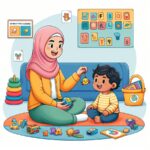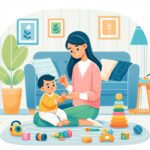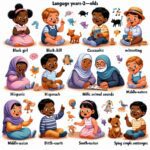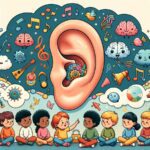Babbling plays a crucial role in the development of a baby’s speech and language skills. It’s not just adorable sounds; it’s the foundation of communication. In this article, we will explore what babbling is, its importance, and how you can support your child through this developmental milestone. Whether you’re a new parent or seeking to understand more about your baby’s growth, this guide will provide you with valuable insights into the world of babbling.
What is Babbling and Why is it Important?
Babbling refers to the repetitive consonant-vowel combinations that babies begin to make as they experiment with sounds. It’s a key stage in language development, typically starting around the age of 4 to 6 months. This vocal play allows babies to practice the sounds needed for speech, laying the groundwork for their first words. Babbling is not only a sign of auditory and speech mechanism development but also a critical step in cognitive and social-emotional growth.
Understanding babbling’s significance helps parents recognize the complexities of their baby’s development and the ways they can support it. Engaging with your baby during this stage, by mimicking sounds and providing a variety of linguistic stimuli, can enhance their language skills. Babbling is your baby’s way of exploring the power of communication, and your response plays a vital role in their continuous learning.
When Should You Expect Babbling to Begin?
While most babies start babbling around 4 to 6 months, there’s a range of normal when it comes to developmental milestones. Some may begin earlier, and others might start a bit later. It’s crucial to observe and celebrate these individual differences, recognizing that each baby follows their unique developmental timeline. If you have concerns about your baby’s development, consulting a pediatric healthcare provider can offer reassurance and support.
During this period, you might notice a transition from cooing—a baby’s first vocalizations composed of soft vowel sounds—to the more complex and varied sounds of babbling. This progression marks a significant leap in your baby’s ability to control their vocal cords and breathe, allowing them to produce a wider range of sounds that mimic the tones and rhythms of the language they hear around them.
How to Encourage Babbling in Babies
Encouraging babbling is all about interaction and providing a stimulating environment. Engage with your baby by talking, singing, and reading to them, emphasizing the back-and-forth exchange of sounds. This not only supports their language development but also strengthens your bond. Here are some tips to foster babbling:
- Respond to your baby’s babbles with enthusiasm, showing that you’re listening and that their ‘voice’ is important.
- Introduce a variety of sounds by playing different types of music, reading books with diverse vocabulary, and describing your daily activities.
- Use baby mirrors during playtime to help them see how their mouth moves when they make sounds.
- Give them time for unstructured vocal play, where they can experiment with making sounds without direct engagement.
By incorporating these practices into your daily routine, you’ll provide your baby with a rich linguistic environment that promotes healthy speech and language development.
Common Concerns About Babbling
Some parents worry when their baby doesn’t begin babbling within the expected timeframe or when babbling seems to decrease. Various factors can influence the development of babbling, including hearing issues, limited exposure to spoken language, or, in rare cases, developmental disorders. It’s essential to observe your baby’s overall development and consult with a healthcare provider if you have any concerns. Early intervention can significantly impact a child’s communication skills.
Remember, the journey through babbling and beyond is unique for every baby. Celebrate the milestones, provide support through challenges, and enjoy the process of watching your baby discover the world of language.
Resources for Further Learning
If you’re interested in learning more about babbling and language development in babies, several resources are available. The American Speech-Language-Hearing Association offers a detailed chart on speech and language developmental milestones. Additionally, exploring our article on babbling, auditory processing, and language development can provide you with a deeper understanding and practical tips.
Remember, as a parent, you play a pivotal role in your child’s language journey. Your interaction, support, and encouragement are invaluable assets that will help your baby navigate the exciting world of communication.













